<% ns_puts [mkm_getnavbar] %>

Advanced Tennis: Sampras Serve
The Racket Path
by John Yandell
Page 1 |
On his first serve, Sampras is averaging 120mph with
spin of about 2700rpm. His second
serve is averaging 85mph with spin reaching almost 5000rpm. These speed/spin ratios are significantly higher than other
top players. The combination
of velocity and heavy spin helps explain why Sampras has led the tour in
percentage of service points and service games won.
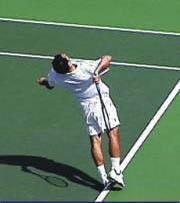 |
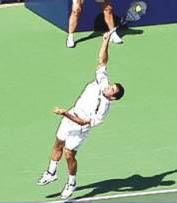 |
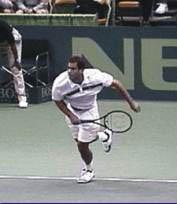 |
Racket Drop |
Contact Point |
Follow-through |
These core positions, racquet drop, contact point, and follow-through are the building blocks of Pete's phenomenal racquet head speed any player can copy. |
||
Generating a serve with this combination of speed and
spin requires amazing racket head speed. No
doubt Sampras’s bionic athletic ability is a major factor in his ability
to accelerate the racket. But another reason is his incredible technical
serving motion. His motion combines
perfect basic bio-mechanics with advanced technical elements, some of
which are unique in pro tennis. The
result - the almost magical ability to hit huge serves at critical
moments.
When it comes to genetic ability, few if any players
can match Pete. But every player
can maximize his own natural ability by using Sampras as a model for
developing technical factors.
This article examines the first and most basic
element that goes into the production of Pete’s exceptional racket head
velocity: the path of the racket
head over the course of the swing. In
subsequent articles, we will examine Pete’s tossing motion and the use
of his left arm, his legs, his advanced body rotation, and his unique ball
and body position at contact, something we call the “left launch.” ![]()
Now on TennisONE!
The racket head path is the single most important
element in developing service power, consistency, and spin. Surprisingly many players at all levels - even very successful
tournament players - have incomplete, tense swing patterns.
The 3 key positions in the swing path on Pete’s serve are a
perfect model for any player looking to improve his technical motion.
These positions are the racket drop, the contact point,
and the follow-through.
Developing these positions require more than a simple
understanding of what you are reading or seeing in this article.
It requires developing a visual image and a kinesthetic feeling of
the positions in your mind’s eye. Don’t
confuse reading this article with developing your serve.
The words and the pictures are a guide to help you internalize what
key technical elements look like and feel like inside your body.
To master these positions you should be able to pass
through them perfectly without hitting the ball, be able to
visualize all the checkpoints, and to execute the swing equally well with
your eyes closed, using the mental image/feeling to guide you.
For information on how visualization works in stroke development,
see the Visual Tennis series in the library, Part
1 and Part 2.)
Key Position 1: Racket Drop
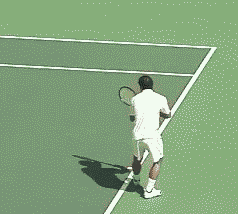
Here Pete demonstrates the full racquet drop, the first core element in maximizing racquet head speed. |
Observe Pete, or any good server: Notice how fully
the racket drops at the completion of the backswing, just prior to
starting up and forward to the ball.
High speed video analysis shows the racket moves at a
fairly slow and constant rate through the course of the windup and the
backswing. The rapid acceleration
really begins after the drop is completed, when the racket starts upward
toward contact. If the drop is
incomplete, the distance the racket head can travel during this critical
acceleration phase is reduced. If,
for example, your drop is only 50% complete, your racket head has a much
shorter distance in which to accelerate, and may reach only 50% of it’s
potential speed.
At the completion of the racket drop, the tip of the
racket falls completely until it is pointing directly at the court
surface. The racket face is close
to and perpendicular to the right side of the
torso.
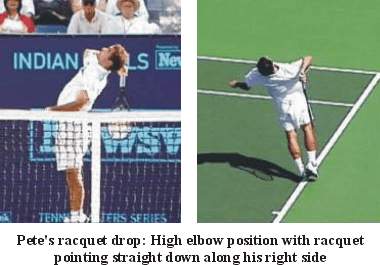
Note the racket never “scratches the back,” falling instead along the right edge of the body. The elbow position is high, slightly above the level of the shoulder.
Sampras, like many of the top players today, uses a compact windup to achievethis perfect drop position. His arms drop down together at the start of the motion. But rather than continuing to trace a circular path with his racket and racket arm, he abbreviates his backswing motion, picking up the hand and racket, raising it to his side and then upward with the racket face pointing downward toward the court.
This motion gives the appearance that the racket hand
is lagging behind, while the tossing arm is moving ahead.
When the tossing arm reaches its fully extended position the racket
and racket arm are actually still down, pointing almost directly at the
court.
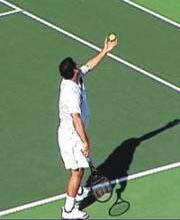
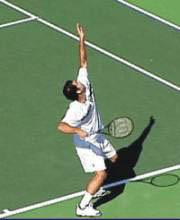
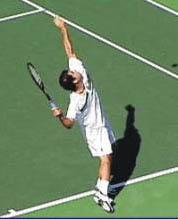
Sampras has a compact backswing, picking up
the racket so that the face points down, but then moving it to the classic
upright position.
But note something important - the racket arm
immediately “catches up”. As
Pete’s tossing arm extends, he holds it up in this stretched position
for about 1/5 of a second. While
the tossing arm is still extended, the racket arm moves upward.
Pete’s arms eventually reach what is generally regarded as a
classic position in the wind up, with the tossing arm and the racket tip
both pointing directly upward. From
here the racket falls to the full drop as described above.
Many players particularly juniors have imitated this abbreviated backswing motion. That’s fine, so long as it works. The key is not the shape of the backswing. The key is whether the backswing delivers the racket to the full drop position. Obviously, Pete’s motion works for Pete. Other players may find a simpler, semi-circular motion similar to that of Mark Philippoussis or John McEnroe is more relaxed and fluid. (See ProStrokes and Mac Serve article.) If you struggle to reach the drop position, or your arm or shoulder feels tight on the backswing, experiment with these alternatives. A circular motion actually works better for most players struggling to achieve a complete racket drop.
Click here for Page 2
To view the complete ProStrokes Gallery of digitally mastered Pete Sampras serves, click here.
Your comments are welcome. Let us know what you about think John Yandell's article by emailing us here at TennisONE.
Last Updated 7/1/00. To contact us, please email to: webmaster@tennisone.com
TennisONE is a registered trademark of TennisONE and SportsWeb ONE; Copyright 1995. All rights reserved.
